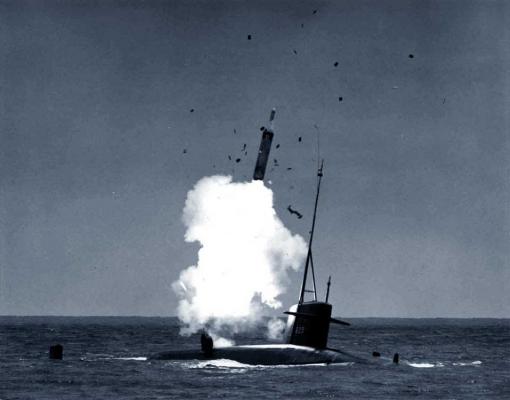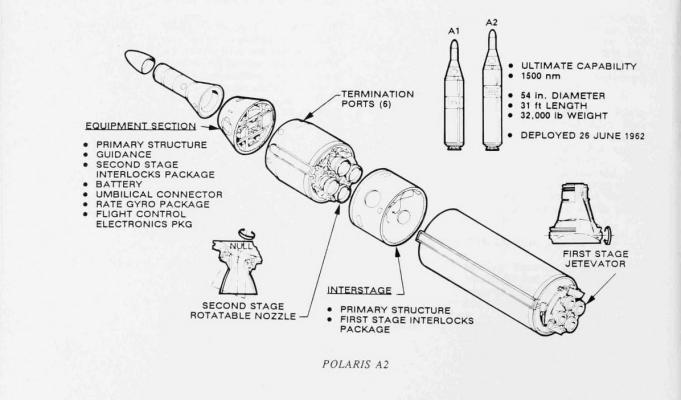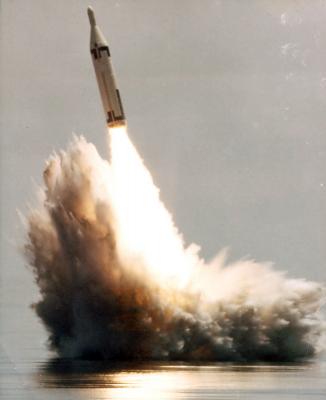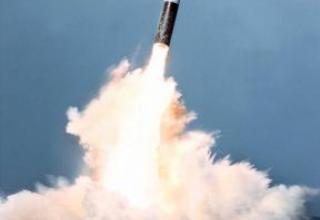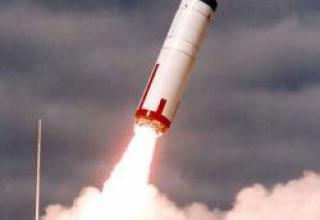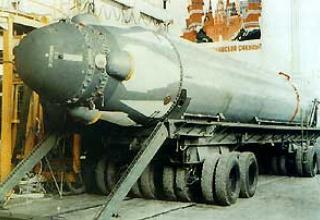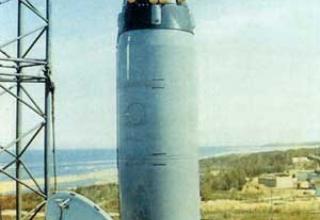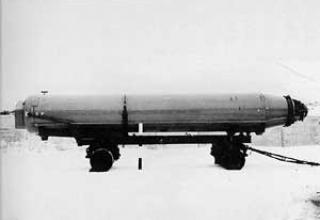The ballistic missile UGM-27B "Polaris A-2" was originally designed to test advanced SLBM construction technologies. It was designed to equip nuclear submarine missile carriers - the Ethan Allen class. These were the first U.S. nuclear submarines specially built to launch underwater missile strikes. Despite external similarities, they were structurally much more advanced than their predecessors, the George Washington-class SSBNs.
The development of the UGM-27B "Polaris A-2" was entrusted to Lockheed Missile Systems Corporation. The designers of the new missile were initially tasked to improve its tactical and technical characteristics of the missile, provided maximum continuity with the SLBM "Polaris-A1" - this allowed to significantly reduce technical risks in the development of a new complex.
The new complex was tested in November 1960 at Eastern Missile Range, Patrick Air Base, Florida. Initially, launches were made from ground launch pads LC-25A and LC-29A (see photo). By December 1961, the main test program was completed - 20 A2X pre-production missiles were launched, 15 launches were successful, 3 were partially successful. In the same year, tests and training and combat launches were also conducted from the waters of the Western Missile Range, Vandenberg Air Base, California. In total, there were 32 test launches of Polaris-A2 SLBMs, 9 of which were unsuccessful. During the testing and active operation of the Polaris-A2 SLBM, 227 launches were made from November 1960 to November 1971, of which 15 were unsuccessful.
For the first time the "Ethan Allen" SSBN went on combat patrol with the new serial A2R missile in June 1962.
All "Ethan Allen" class missile carriers from the end of 1962 to the summer of 1963 were introduced into the 14th Squadron (base - Holy Loch, UK). The Mediterranean Sea was selected as a combat patrol area. Taking into account the range of missile fire, it can be concluded that strategically important sites of the Ukrainian SSR, the Caucasus, the South Urals and Central Asia were chosen as possible targets for these SSBNs.
The initial plans to deploy UGM-27B missiles on only five Ethan Allen-class missiles were adjusted towards significant expansion - new missiles were also deployed on the first eight (out of 31) Lafayette-class nuclear submarines built. This was due to the significant delay in the preparation of the main missile for this class of ships, the new Polaris-A3 SLBM. In order not to delay the introduction of the missiles, it was decided to equip them with a less modern but already proven SLBM. The Polaris-A2 missile started to be decommissioned in January 1968, but due to the adoption of the latest Poseidon-C3 SLBMs by the fleet, the process of parting with the old SLBM was significantly delayed and the last missile carrier equipped with it, the John Marshall SSBN, unloaded its missiles from mines only in November 1974.
It should be noted that Polaris-A2 was actively used, like its predecessor Polaris-A1, in various testing programs as well. The first of them was the program of testing of the Mk II control system and materials for the Mk2 combat unit of the then advanced Polaris-A3 SLBM. A total of eight missiles were used - four A2G missiles tested the new control system, two A2M missiles tested the materials of the new booster, and two more A2MG were tested together. Launches were held from November 1961 to December 1962, 4 - successfully, 3 - partially successful. They were not included in the overall standings for launches of A2X missiles mentioned above.
In 1971, already at the curtain of its career, the Polaris-A2 SLBM was used as a target missile in the development of the U.S. Safeguard Test Target Program (SSTTP). The Polaris-A2 missile simulated Soviet P-21 and P-27 SLBMs. In total, it was planned to launch 22 Polaris-A2 missiles in three configurations - with the standard combat unit Mk1 and PX-1 (5 pieces), with the Mk2 combat unit from the Polaris-A3 (5 pieces) and with the Mk2 combat unit and a special APEX adapter (Auxiliary Payload EXtension) of 12 pieces. The last configuration is of special interest - the APEX adapter contained false targets designed for the Air Force. Later in the same adapter were placed additional calibration spheres of copper with a diameter of 38 cm, shot off and led to a separate trajectory, and to the tail of some missiles were attached by special tie-ups special inflatable false targets RADs (Radar Augmentation Devices), also owned by the Air Force. The launches were planned for the Kwajalein Atoll area in the Pacific Ocean from Observation Island. In reality, however, the program has acquired a much more modest appearance - from April to December 1971, this program was carried out 4 launches of missiles only in Mk2/APEX configuration, 3 of which were additionally equipped with copper spheres. Also on some missiles were used false targets RADs. All launches were assessed as successful.
Composition:
The UGM-27B ballistic missile partially inherited the design features of its predecessor, the UGM-27A "Polaris-A1" SLBM. The missile is designed as a two-stage rocket with serial connection of stages.
The A2P first stage RTDT, traditionally developed by Aerojet General, had four rotary nozzles. Nozzles were made of aluminum alloy with special coatings. To control the engine thrust vector on the first stage of the rocket used ring deflectors, mounted on each of the nozzles and articulated with the appropriate hydraulic drives (this system has proven its viability on the UGM-27A). Tests have shown the high efficiency of this type of steering device and, in particular, the ability to retrace the missile's trajectory even if the vertical deflection is significant when the first stage engine is turned on. The control system made it possible to control the missile through pitch, yaw and roll channels. The engine was powered by an electromechanical device and a powerful fuse, while the nozzle plugs, which protected the engine from water ingress during the underwater course of the missile, were pushed out by the working gas pressure at the moment of engine activation. Compared with the first stage A1P of the UGM-27A rocket, the A2P stage was extended by a special 7.62m long insert. Like the A1P stage, the A2P stage was welded from high-strength vanadium stainless steel AMZ-256 with a yield point of 160-170 kg/mm2. The fuel of the first stage engine remained practically unchanged - polyurethane with aluminum and ammonium perchlorate additive (fuel ANP 2639AF). Aluminium additive is used to increase fuel combustion stability and specific impulse.
On a second stage rocket engine developed by Hercules Powder with extensive participation of the Polaris Systems Division of Johns Hopkins University's Applied Physics Laboratory, "Polaris Division), Allegany Ballistics Laboratory and Cleveland Pneumatic Industries Corporation installed four rotary nozzles, also made of specially coated aluminium alloy. The control force mechanism for swiveling nozzles has been improved over a similar first stage mechanism, which has reduced and simplified the inertial mass of the stage, while improving reliability and efficiency (see diagram). This system made it possible to control the rocket with confidence in the second stage operation area through all channels. The main innovation applied at the second stage is the structural material of the stage body. For the first time in the world it was possible to create a marching step of the SLBM from organic materials - by winding threads from fiberglass with impregnation by an epoxy composition. Such step has allowed to lower essentially inert weight of the second step. It turned out to be a difficult technical task to place a thrust cut-off unit with six holes cut by detonating elongated charges in the front part of the second stage body in the power structure of the stage made of organic materials. The thrust cut-off device of the second stage marching engine allowed to vary the missile's range of flight. The second stage used a more advanced, blended modified dual-base solid propellant DDT-70.
The charge in the RDTT of each stage has an inner cavity in the form of a star running along the longitudinal axis of the fuel charge - in the first stage it is six-beam, in the second stage it is twelve-beam.
The steps were connected using an aluminium alloy adapter. A fire method was used to separate the marching steps. In a forward part of the adapter the charge which worked at the moment of division was fixed. Such way was used and is used practically on all American SLBMs.
The missile flight after leaving the launch shaft of the SSBN was carried out according to a predetermined program without adjustment from the submarine missile carrier, which put high demands on the navigation and pointing systems of the complex. The autonomous inertial control system used in the complex ensured the output of the missile on a given trajectory, stabilization of its flight and shutdown of the second stage engine of the missile when reaching a given speed. The control system equipment is located in an inseparable instrument compartment, which was located in the front of the second stage of the missile. It housed a platform with accelerometers and a block of high-speed gyroscopes, a software flight control system, a block of auxiliary electrical equipment, computer, power supplies, etc. The control system was developed by General Electric and Hughes with participation of Massachusetts Institute of Technology. Compared to its predecessor, the Polaris-A2 SLBM control system has been slightly modified to maintain the accuracy of the Polaris-A1 SLBM while increasing the range of the new SLBM.
The missile was equipped with an in-flight detachable monobloc warhead consisting of an Mk1 combat unit (modification B) and a 600 kt W-47 mod.2 thermonuclear warhead (or, alternatively, a heavier W-47 mod.3 thermonuclear warhead with an output of up to 800 kt and, according to some sources, up to 1 Mt). It was also possible to install the Mk1 (modification A) combat unit and the 600 kt W-47 mod.1 thermonuclear warhead instead of the UGM-27A missile's conventional HC head unit. The combat equipment of the Polaris-A2 SLBM made it possible to strike weakly defended surface targets (primarily large cities, which fit into the then American doctrine of "mutual assured destruction").
In addition, this SLBM was historically the first SLBM to receive a SSBN. The program to develop the complex, called "PX-1", began in November 1961 and was conducted by Lockheed. In July - December 1962, there were 12 test launches of the modified A2T missile with the complex on board - 7 launches were evaluated as successful, which gave the right to the creators to talk about the successful completion of the test program. In the period from July 1963 to July 1964, the U.S. Navy received 221 sets of "PX-1" for deployment on the "Polaris A-2" SLBM, which had already been adopted for service by that time.
According to published reports, the PX-1 package consisted of the Polaris A-2 SLBM:
- 6 lightweight decoys and two dipole reflector containers placed on a special adapter between the booster and the 11.5 cm long section of the SU, the firing of the BC and the formation of the dipole reflector fields were carried out after the separation of the booster, after which the adapter also fired from the second stage of the missile, itself becoming a heavy decoys;
- 2 generators of active interference and one container for dipole reflectors placed on the bottom part of the booster, which were fired after the end of the work of the unit specially installed on the booster RDTT orientation to the position with the smallest ESR with respect to the radar field of radar SPRN and ABM.
Also part of the BMD SLCM was a second stage retreat system away from the flight path of the combat equipment, so that the stage having a significant EPR and the next stage at a small distance from the combat equipment could not serve as a target point for anti-missile systems. According to U.S. experts, this SSB missile defense system could reliably protect the ballistic missile from detection up to a height of 30.5 km.
However, the mass deployment of the PX-1 system did not happen - it was equipped with only one SSBN of Polaris A-2 missile carriers (in total, these SSBNs were deployed on 13 SSBNs).
American sources cite the following reasons for the incident:
- the unreliability of active interference generators;
- problems with training and missile maintenance;
- reduced range of missiles equipped with anti-missile defense systems;
- overestimation by the Americans of the level of anti-missile defense deployment in the USSR (the latter was successfully "helped" by the USSR state security bodies, which successfully carried out large-scale disinformation of the likely enemy), therefore, by the time the PX-1 ABM system was deployed, the Americans already considered it "not corresponding to the level of threats of the current moment.
In the missile compartment of each SSBN equipped with Polaris-A2 missiles, 16 launchers were installed. Each of them had a classical design - it consisted of a shaft, a hydraulically driven lid, lid seal, a steel launch cup, a membrane and equipment for feeding low-temperature steam-gas mixture produced by an individual gas generator for each PU. The system ensures discharge of SLBMs from depths not exceeding 30-40 m (depending on SSBN class) to a height of about 10 m above the water surface. All 16 missiles could be launched in 16 minutes. The SLBM launch method is submarine, but there were successful experiments to launch the UGM-27B SLBM from an above-water position.
Characteristics:
| The length of the rocket, m | 9.45 |
| The diameter of the rocket, m | 1.37 |
| Weight in gear, t. | 13.6 |
| Assembly weight BB+HF, t | 0.50 |
| HF power, Mt. | 0.8 |
| Range of fire maximum, km | 2800 |
| Circular probable deviation, m. | 3700 |
| 1-stage engine traction at sea level, kN | 311 |
| Apogee height of PPP trajectory, km | 1000 |
Sources:
- Johns Hopkins APL Technical Digest, Volume 19, Number 4, P.375-387, 1998
- А.А. Шумилин «Авиационно-космические системы США». Москва, «Вече», 2005.
- www.lockheedmartin.com
- www.astronautix.com
- www.nuclearweaponarchive.org
- www.globalsecurity.org
- www.fas.org
- www.arms.ru
- www.militaryparitet.com
- www.orugie.ru
- www.dodmedia.osd.mil
- www.navsource.org
